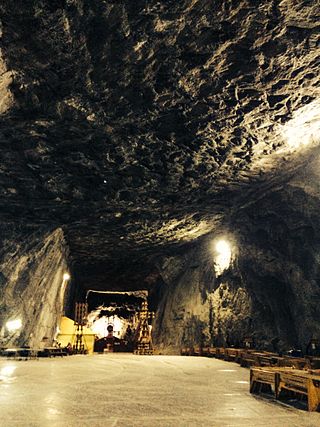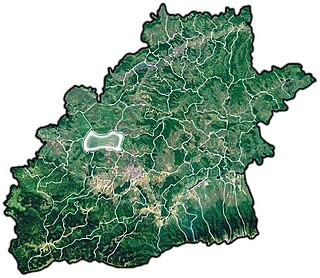
According to the 2021 Romanian census, 2,137 Poles live in Romania, mainly in the villages of Suceava County. There are three exclusively Polish villages, as follows: Nowy Sołoniec, Plesza (Pleșa), and Pojana Mikuli, as well a significant Polish presence in Kaczyca (Cacica) and Paltynosa (Păltinoasa). There is also a relatively sizable number of ethnic Poles living in the county seat, Suceava.

The Mureș or Maros is a 789-kilometre-long (490 mi) river in Eastern Europe. Its drainage basin covers an area of 30,332 km2 (11,711 sq mi). It originates in the Hășmașu Mare Range in the Eastern Carpathian Mountains, Romania, rising close to the headwaters of the river Olt, and joins the Tisza at Szeged in southeastern Hungary. In Romania, its length is 761 km (473 mi) and its basin size is 27,890 km2 (10,770 sq mi).

Bălțătești is a commune in Neamț County, Western Moldavia, Romania. It is composed of three villages: Bălțătești, Valea Arini, and Valea Seacă. It also included Ghindăoani village until 2003, when it was split off to form Ghindăoani Commune.

Solca is a town in Suceava County, northeastern Romania. It is situated in the historical region of Bukovina. Solca is the smallest town in the county and the third-smallest town in Romania, with a population of 2,405 inhabitants, according to the 2021 census. Its name is derived from that of the river flowing through it, in turn derived from Slavic sol ("salt") – in reference to the area's salty springs. Solca is known for its high quality air, for being a former spa, and for the beer that was manufactured here.

Cacica is a commune located in Suceava County, in the historical region of Bukovina, northeastern Romania. The commune is located in the central part of the county, 17 km (11 mi) from the town of Gura Humorului, 34 km (21 mi) from the city of Rădăuți, and 28 km (17 mi) from the county seat, Suceava. At the 2011 census, 74.8% of inhabitants were Romanians, 20.2% Poles, and 4.4% Ukrainians. Its Polish inhabitants are descended from settlers who arrived there at the turn of the 19th century during the Habsburg period.
The Valea Blaznei mine is a large mine in the north of Romania in Rodna, Bistrița-Năsăud County, 50 km southwest of Bistrița and 699 km north-west of the capital, Bucharest. Valea Blaznei represents one of the largest lead and zinc reserve in Romania having estimated reserves of 10.5 million tonnes of ore grading 0.76% lead and 2.48% zinc thus resulting in 0.08 million tonnes of lead and 0.26 million tonnes of zinc.

Salina Turda is a salt mine in the Durgău-Valea Sărată area of Turda, the second largest city in Cluj County, northwest Transylvania. Opened for tourists in 1992, the Salina Turda mine was visited by about 618,000 Romanian and foreign tourists in 2017.
The Valea Chioarului mine is a large mine in the northwest of Romania in Maramureș County, 30 km south of Baia Mare and 520 km northwest of the capital, Bucharest. Valea Chioarului represents one of the largest bentonite reserve in Romania having estimated reserves of 20 million tonnes.

The Târgu Ocna mine is a large salt mine located in eastern Romania in Bacău County, close to Târgu Ocna. Târgu Ocna represents one of the largest salt reserves in Romania having estimated reserves of 229 million tonnes of NaCl.
The Gura Slănic mine is a large salt mine located in eastern Romania in Bacău County, close to Târgu Ocna. Gura Slănic represents one of the largest salt reserves in Romania having estimated reserves of 1 billion tonnes of NaCl.
The Bălțătești mine is a large salt mine located in northern Romania in Neamț County, close to Bălțătești. Bălțătești represents one of the largest salt reserves in Romania having estimated reserves of 200 million tonnes of NaCl.
The Sărata mine is a large salt mine located in eastern Romania in Bacău County, close to Sărata. Sărata represents one of the largest salt reserves in Romania having estimated reserves of 2.2 billion tonnes of NaCl.
The Paltin-Nistorești mine is a large salt mine located in eastern Romania in Vrancea County, close to Paltin and Nistorești. Paltin-Nistorești represents one of the largest salt reserves in Romania having estimated reserves of 22 billion tonnes of NaCl.
The Sările-Bisoca mine is a large salt mine located in eastern Romania in Buzău County, close to Bisoca. Sările-Bisoca has one of the largest salt reserves in Romania having estimated reserves of 13 billion tonnes of sodium chloride.
The Foleşti mine is a large salt mine located in southern Romania in Vâlcea County, close to Tomșani. Foleşti represents one of the largest salt reserves in Romania having estimated reserves of 22 billion tonnes of NaCl.
The Ogra mine is a large salt mine located in central Romania in Mureș County, close to Ogra. Ogra represents one of the largest salt reserves in Romania having estimated reserves of 100 billion tonnes of NaCl.

The Praid mine is a large salt mine located in central Romania in Harghita County, close to Praid. Praid represents one of the largest salt reserves in Romania having estimated reserves of 50 billion tonnes of NaCl. The Praid salt mine is also an attraction on the route of the Via Transilvanica long-distance trail, which passes through the village of Praid.

The Ocna Mureș mine is a large salt mine located in central Romania in Alba County, close to Ocna Mureș. Ocna Mureș represents one of the largest salt reserves in Romania having estimated reserves of 200 million tonnes of NaCl.
The Valea Vinului mine is a large mine in the northwest of Romania in Rodna, Bistrița-Năsăud County. Valea Vinului represents one of the largest lead and zinc reserve in Romania having estimated reserves of 5.25 million tonnes of ore grading 0.79% lead and 2.48% zinc thus resulting in 0.04 million tonnes of lead and 0.13 million tonnes of zinc.

Lacul Negru is a natural salt lake in the town of Ocna Sibiului, Sibiu County, Transylvania, Romania. It is one of the many lakes of the Ocna Sibiului mine, a large salt mine which has one of the largest salt reserves in Romania. It has one of the smallest depths of all the lakes, with its maximum depth only reaching about 1 metre.











